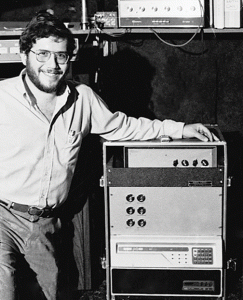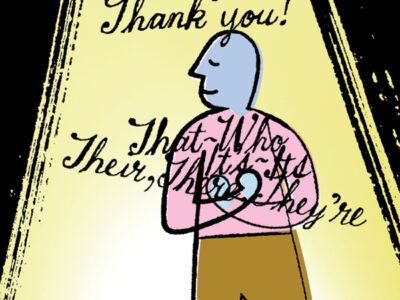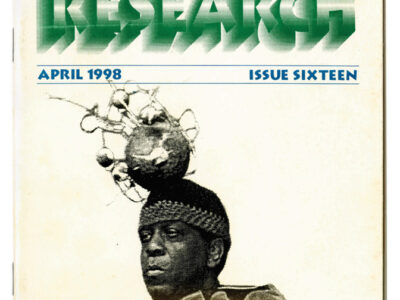 Harry Mendell EE’76 GEE’76 still speaks with the earnest, slightly impatient air of a lifelong tinkerer, the sort of guy who can’t help but think in terms of untapped possibilities, new paradigms, stubborn problems to be solved.
Harry Mendell EE’76 GEE’76 still speaks with the earnest, slightly impatient air of a lifelong tinkerer, the sort of guy who can’t help but think in terms of untapped possibilities, new paradigms, stubborn problems to be solved.
“My interest is in innovating rather than refining,” he says matter-of-factly—offering the statement as neither apology nor boast—one recent afternoon in his Upper East Side apartment.
On a wall just inside the apartment door hangs a platinum record for The Woman in Red, Stevie Wonder’s soundtrack to the 1984 film. That plaque, commemorating sales of one million copies, is just one of the more conspicuous pieces of evidence attesting to Mendell’s pursuit of innovation, which brought some rather momentous results during his undergraduate years at Penn.
It was then, in the mid-1970s, that Mendell invented the world’s first digital sampling synthesizer at an electronic-music laboratory that had been set up in the Annenberg Center. This technology, which would later become an essential feature of popular music, allowed a musician to record a sample, digitize it, and then manipulate it through the keyboard of a synthesizer.
In his critically acclaimed new book Mo’ Meta Blues: The World According to Questlove, Ahmir “?uestlove” Thompson, the drummer and bandleader of the Roots, opines that hip-hop was forever changed by an episode of The Cosby Show—specifically, a scene in which the Cosby kids join Wonder in the studio, where he shows off a sampling synthesizer. Mendell isn’t in that scene, but to some degree he’s the man behind the curtain. The magic at hand is the byproduct of his enterprise.
“I was fascinated by anything that was sort of a bridge between the arts and sciences,” Mendell recalls of his undergraduate self. That interest quickly led him to a course on the Moog synthesizer taught by Dan Coren, a junior member of the music faculty whose official area of expertise was quite literally Wagnerian.
Mendell and Coren bonded over a shared interest in electronic music, then still largely uncharted terrain.
“Harry was a brilliant visionary, very sure of himself and with an enormous ego,” Coren recalls, “but he also respected my musical knowledge and, to put it simply, was a good friend.”
Working with the Moog, an analog synthesizer, Mendell began to wonder how it could be adapted to the emerging field of computing.
“So I convinced Dan to divert a small amount of money, which was going to buy a reverberation plate, to buy a computer instead,” he says—“even though the plate was $4,000 and the computers were astronomically priced in those days.” In a feat of impressive hustle, Mendell tracked down a salesman from the old Digital Equipment Corporation, which had a contract with the University, and convinced him to cut a special deal.
“They took about $100,000 of equipment and marked it as used, even though it was assembled at the Center by technicians,” Mendell recalls, adding with a chuckle: “I was very resourceful at that time.” His resourcefulness extended further, as he established a working signal between the computer and the Moog, years before any MIDI system, a standard digital-to-analog interface, was established.
The computer, a PDP-8, was state-of-the-art, though because of the intended purchase that it derailed, Coren made Mendell promise that he’d program it to simulate reverb. Mendell hastily agreed, though he had no idea precisely how that would be done.
“So then I started digitizing sounds by using an A/D converter,” explains Mendell, the cadence of his speech quickening. “But it wasn’t designed for capturing sound, it was designed for laboratories. So I had to figure out how to de-noise it, how to put the filters in front of it. I didn’t begin to know what I was getting involved in, but I would call different people in the engineering school and discuss what was going on.”
One faculty member he contacted, Max Mintz GM’66, was teaching a course in digital filters at the time.
“Back then the filters were used for radar systems, not audio systems,” Mendell says. “[Mintz] gave me the math and I tried it and figured it out and got it to do a good job recording audio.”
Mendell deduced that he needed both an anti-aliasing filter and a sample-and-hold circuit (ask your engineering buddies) along with some means of manipulating digital delay. Long story short, he created a crude sampling synthesizer with the equipment at hand. “Just really tinkering in the basement there,” he says.
One striking thing about his breakthrough: it was the product of extracurricular pursuits. A photograph from the time shows him at a console in the Annenberg lab—bearded, bespectacled, tousled—in what looks like the weary grip of obsession. “My thesis was about computer vision, something completely different,” he says. “I designed one of the first solid-state imaging systems.” (He’d been interested in exploring visual replacement for blind people, “which was way ahead of its time.”)
Mendell and Coren formed a company, Computer Music Incorporated, for the purpose of commercializing their sampling synthesizer, which they called the Melodian. A demo tape they sent out to recording studios featured a variety of explicitly nonmusical timbres (a bouncing basketball, a belch) playing familiar tunes. No one recognized the potential until one of Stevie Wonder’s recording engineers saw Mendell’s presentation at an industry show. Before long, Mendell found himself in the studio helping Wonder make Journey Through the Secret Life of Plants, an album that features the Melodian on almost every track, notably one that shapes a melody out of recorded birdsong.
Wonder, who is hailed today as a synthesizer pioneer, was an ideal collaborator for Mendell: intellectually curious, with the patience and resources to pursue an idea to completion. They ended up working together for about a decade on more commercial albums. (The Woman in Red is the one that gave us “I Just Called to Say I Love You,” though the Melodian seems to play more of a role on a track called “Don’t Drive Drunk,” which became the cornerstone of a nationally televised public service announcement.)
Meanwhile, Mendell and Coren parted ways and dissolved their company. (Coren, who left academia to become a software developer, credited the rift to personal issues and “diverging life situations,” though he also noted that Mendell “made my career possible.”) Mendell worked with a handful of other musical acts, including Bon Jovi, whose keyboardist consulted with him for synthesizer lessons. (You’ll find his name in the acknowledgments for the blockbuster 1986 album Slippery When Wet.)
Mendell licensed the Melodian technology to Yamaha, which used it to make a chip for commercial purposes. He also worked with Commodore. When I mention the toy keyboard I had as a kid, a Casio with basic sampling capacity, Mendell smiles; it was almost certainly running on one of those chips or a technological descendant.
Eventually Mendell drifted out of the music realm, taking a job at Bell Laboratories, where he was part of a group that worked on the Unix system. (“I actually developed a chip for managing memory,” he says, “and it’s still the same system they use.”) In recent years he has worked in various areas of finance, having to do with risk management, algorithmic trading, machine learning, and natural-language processing.
“And actually I’ve gotten some ideas in applying it back to music,” he says. The creative side of the music business—which his son, Harris, has explored as a member of Sundials, an indie punk band out of Richmond, Virginia—still appeals to Mendell. By his assessment, the full potential for sampling was never really reached, since so many musicians used it to repurpose other music, rather than creating new timbres from scratch.
“That voice effect you hear people use all the time,” he says, referring to Auto-Tune—“I thought there would be a lot more creative things like that, but with more instruments. So you would have this whole new palette that people could operate with. It never really happened.” He adds: “I can’t tell you how many times I almost threw myself back into it.”
A few days after our meeting, Mendell sends an email with the subject line “Exactly what I had in mind (in 1975)!” Within it is a link to a New York Times article <http://www.nytimes.com/2013/06/05/arts/music/tower-music-from-eiffel-tower-by-joseph-bertolozzi.html> about the composer Joseph Bertolozzi, who has been recording sounds made by striking various parts of the Eiffel Tower, and who plans to assemble the samples into an hour-long composition called “Tower Music.”
Hailing this as “precisely the kind of idea that Dan Coren and I dreamed about when we invented the sampler,” Mendell conveys something like wistfulness, perceptible even across the ether. “It is still hard for me to understand why first of all it took so long to happen,” he writes, “and why there is not more music made from interesting non-instrumental sounds.”
—Nate Chinen C’97




